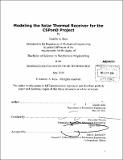| dc.contributor.advisor | Alexander Slocum. | en_US |
| dc.contributor.author | Rees, Jennifer A. (Jennifer Anne) | en_US |
| dc.contributor.other | Massachusetts Institute of Technology. Dept. of Mechanical Engineering. | en_US |
| dc.date.accessioned | 2012-01-30T17:03:04Z | |
| dc.date.available | 2012-01-30T17:03:04Z | |
| dc.date.issued | 2011 | en_US |
| dc.identifier.uri | http://hdl.handle.net/1721.1/68918 | |
| dc.description | Thesis (S.B.)--Massachusetts Institute of Technology, Dept. of Mechanical Engineering, June 2011. | en_US |
| dc.description | "June 2011." Cataloged from PDF version of thesis. | en_US |
| dc.description | Includes bibliographical references (p. 23). | en_US |
| dc.description.abstract | The objective was to create an accurate steady state thermal model of a molten salt receiver prototype with a horizontal divider plate in the molten salt for Concentrated Solar Power on Demand (CSPonD). The purpose of the divider plate is to separate the heated salt on the top from the colder salt on the bottom while allowing some of the salt to pass around the plate. The thermal model used is a one dimensional resistance model which uses bulk temperatures for the top and bottom layers of salt. An assumption needed to be made to allow the model to be solvable, so it was modeled using two different assumptions, a given energy input and a given top salt bulk temperature. The system was solved for the maximum and minimum heights that the divider plate transverse, with the top of the plate being 2 centimeters and 5.5 centimeters from the bottom of the receiver. The given energy for the two heights was 1,598W for the 2 centimeter height and 1,512W for the 5.5 centimeter height. For the given top temperature for the two heights the temperatures were 367.2°C for 2 centimeter height and 360.0°C for 5.5 centimeter height. It was observed that both models showed correlation with the trends in the temperature gradients and heat losses as the tested experiment, varying at a maximum temperature difference of 55K to a minimum of less than 2K. The observations show that the assumed temperature models show a closer correlation with the experimental results than the assumed energy model. The experiment, however, was only run for 8000s, which suggests that it might not have reached steady state making the energy model the better model for steady state analysis. | en_US |
| dc.description.statementofresponsibility | by Jennifer A. Rees. | en_US |
| dc.format.extent | 24 p. | en_US |
| dc.language.iso | eng | en_US |
| dc.publisher | Massachusetts Institute of Technology | en_US |
| dc.rights | M.I.T. theses are protected by
copyright. They may be viewed from this source for any purpose, but
reproduction or distribution in any format is prohibited without written
permission. See provided URL for inquiries about permission. | en_US |
| dc.rights.uri | http://dspace.mit.edu/handle/1721.1/7582 | en_US |
| dc.subject | Mechanical Engineering. | en_US |
| dc.title | Modeling the solar thermal receiver for the CSPonD Project | en_US |
| dc.type | Thesis | en_US |
| dc.description.degree | S.B. | en_US |
| dc.contributor.department | Massachusetts Institute of Technology. Department of Mechanical Engineering | |
| dc.identifier.oclc | 773696196 | en_US |
